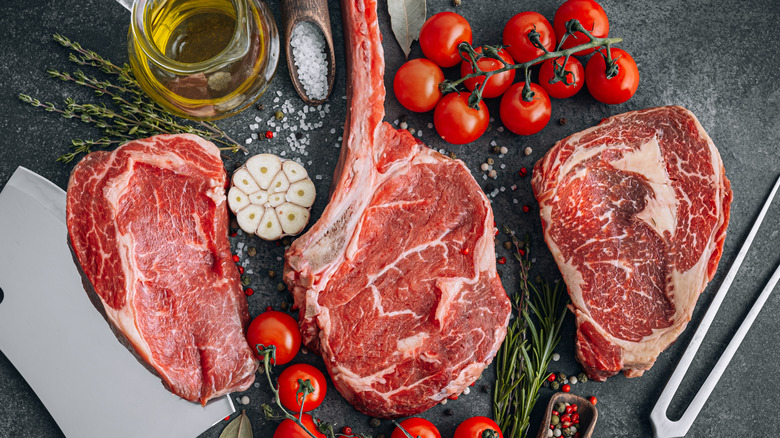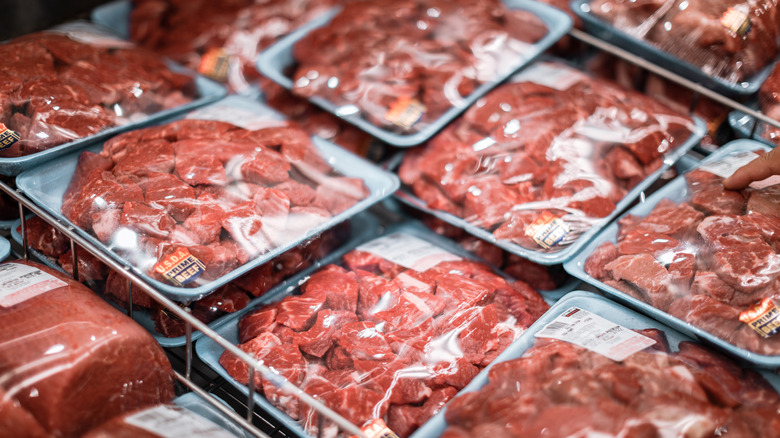Why Your Upcoming Holiday Meals Could Put A Dent In Your Wallet
With many of us back in the office, and with children back at school, we can be forgiven for thinking that pandemic days are behind us. But there are still signs that things aren't quite as normal as we'd like to believe. And those signs are everywhere, from the presence of hand sanitizing stations to lingering mask mandates.
If there's one place where we're reminded that things won't be as they were for some time, it's at the grocery store, where the dollar doesn't go as far as it used to. And the price hikes that are hitting our wallets don't seem to show any signs of slowing down. The cost of items like meat, poultry, and seafood rose 1.7% between September and October, and 11.9% when you compare overall food prices between October of 2020 and 2021, according to CNBC.
Experts agree that one item that is causing our grocery bills to skyrocket is beef, whose wholesale price climbed just over 14% between July and August 2021 alone. Those who study the market have even said that we shouldn't be surprised if the increase in wholesale beef prices adds up to a whopping 20% increase by the end of this year, per Ag Web. And it doesn't help us to know that around this time in 2020, meat prices had fallen to record lows.
There are a basket of reasons to explain rising beef costs
It would be too easy to pin the blame for surging beef prices on one factor, but the Association for Supply Chain Management's Peter Bolstroff tells Quartz that it's not as simple as that. "Anytime you see price increases like that, it's never one thing, it's always a stack of things. [When] these prices go up that fast ... usually it's because you've got demand shocks and supply shocks stacking on themselves at the same time," he said to the outlet.
Wells Fargo chief agriculture economist Michael Swanson also told Quartz that for starters, we can blame the coronavirus pandemic, which sickened thousands of meatpacking workers at the outset, forcing production facilities to slow down, and cutting into beef production. Not only has that failed to recover, but the beef supply chain is also being plagued with rising transport charges associated with higher fuel prices and rising feed prices.
As a result, Tyson Foods, which produces about 20% of all the meat and chicken consumed in the United States, says it's had to increase prices. The cost of ingredients and packaging materials has gone up, and Tyson is facing higher labor costs because it introduced wage increases and a sick leave policy to fight a labor shortage. "The inflation we incur needs to be passed on. Some of the inflation for us has been substantial," the company's chief financial officer, Stewart Glendinning, said to The Wall Street Journal.
Companies are using inflation to hide price increases
Tyson Foods isn't exactly suffering. Skyrocketing meat prices have given the company an earnings boost of 12%, so it made $12.8 billion during its fiscal fourth quarter, per The Wall Street Journal. And Tyson isn't alone.
In a separate report, the Journal said companies are also using inflation as a chance to raise their own prices and increase profitability in the process. Nearly two-thirds of America's biggest publicly-traded firms are reporting healthier profit margins than they did before the COVID-19 pandemic. While profit margins tend to grow when inflation spikes, companies also expose themselves to the likelihood that customers will eventually get frustrated because they are paying and walk away. That loss of trust could hurt a company in a way that could well take years to recover.
On November 14, Treasury Secretary Janet Yellen blamed rampant inflation on the ebb and flow of the pandemic, saying that things can only return to normal once we get COVID-19 under control. She told CBS' "Face the Nation" (via Politico), "It really depends on the pandemic. The pandemic has been calling the shots for the economy and for inflation." Given that timeline, Yellen says we could see price tags reflect a "return to normal" sometime in 2022.


